Pressmeddelande
Watching a 'New Star' Make the Universe Dusty
VLTI observes for the first time how dust forms around an erupting star
24 juli 2008
Using ESO's Very Large Telescope Interferometer, and its remarkable acuity, astronomers were able for the first time to witness the appearance of a shell of dusty gas around a star that had just erupted, and follow its evolution for more than 100 days. This provides the astronomers with a new way to estimate the distance of this object and obtain invaluable information on the operating mode of stellar vampires, dense stars that suck material from a companion.
Although novae were first thought to be new stars appearing in the sky, hence their Latin name, they are now understood as signaling the brightening of a small, dense star. Novae occur in double star systems comprising a white dwarf - the end product of a solar-like star - and, generally, a low-mass normal star - a red dwarf. The two stars are so close together that the red dwarf cannot hold itself together and loses mass to its companion. Occasionally, the shell of matter that has fallen onto the ingesting star becomes unstable, leading to a thermonuclear explosion which makes the system brighter.
Nova Scorpii 2007a (or V1280 Scorpii), was discovered by Japanese amateur astronomers on 4 February 2007 towards the constellation Scorpius ("the Scorpion"). For a few days, it became brighter and brighter, reaching its maximum on 17 February, to become one of the brightest novae of the last 35 years. At that time, it was easily visible with the unaided eye.
Eleven days after reaching its maximum, astronomers witnessed the formation of dust around the object. Dust was present for more than 200 days, as the nova only slowly emerged from the smoke between October and November 2007. During these 200 days, the erupting source was screened out efficiently, becoming more than 10,000 times dimmer in the visual.
An unprecedented high spatial resolution monitoring of the dust formation event was carried out with the Very Large Telescope Interferometer (VLTI), extending over more than 5 months following the discovery. The astronomers first used the AMBER near-infrared instrument, then, as the nova continued to produce dust at a high rate, they moved to using the MIDI mid-infrared instrument, that is more sensitive to the radiation of the hot dust. Similarly, as the nova became fainter, the astronomers switched from the 1.8-m Auxiliary Telescopes to their larger brethren, the 8.2-m Unit Telescopes. With the interferometry mode, the resolution obtained is equivalent to using a telescope with a size between 35 and 71 metres (the distance between the 2 telescopes used).
The first observations, secured 23 days after the discovery, showed that the source was very compact, less than 1 thousandth of an arcsecond (1 milli-arcsecond or mas), which is a size comparable to viewing one grain of sand from about 100 kilometres away. A few days later, after the detection of the major dust formation event, the source measured 13 mas.
"It is most likely that the latter size corresponds to the diameter of the dust shell in expansion, while the size previously measured was an upper limit of the erupting source," explains lead author Olivier Chesneau. Over the following months the dusty shell expanded regularly, at a rate close to 2 million km/h.
"This is the first time that the dust shell of a nova is spatially resolved and its evolution traced starting from the onset of its formation up to the point that it becomes too diluted to be seen", says co-author Dipankar Banerjee, from India.
The measurement of the angular expansion rate, together with the knowledge of the expansion velocity, enables the astronomer to derive the distance of the object, in this case about 5500 light-years.
"This is a new and promising technique for providing distances of close novae. This was made possible because the state of the art facility of the VLTI, both in terms of infrastructure and management of the observations, allows one to schedule such observations," says co-author Markus Wittkowski from ESO.
Moreover, the quality of the data provided by the VLTI was such that it was possible to estimate the daily production of dust and infer the total mass ejected. "Overall, V1280 Sco probably ejected more than the equivalent of 33 times the mass of the Earth, a rather impressive feat if one considers that this mass was ejected from a star not larger in radius than the Earth," concludes Chesneau. Of this material, about a percent or less was in the form of dust.
Mer information
"VLTI monitoring of the dust formation event of the Nova V1280 Sco", by O. Chesneau et al. appears today in the research journal Astronomy and Astrophysics.
The team is composed of O. Chesneau, S. Sacuto, and A. Spang (CNRS/OCA, Grasse, France), D. P. K. Banerjee, N. M. Ashok and R. K. Das, (Physical Research Laboratory, Gujarat, India), F. Millour, N. Nardetto and S. Kraus (Max-Planck-Institut für Radioastronomie, Bonn, Germany), E. Lagadec (Department of Physics and Astronomy University of Manchester, UK), and M. Wittkowski, C. Hummel, M. Petr-Gotzens, S. Morel, F. Rantakyro, and M. Schöller (ESO).
A French press release is available at http://fizeau.unice.fr/article.php3?id_article=189
Kontakter
Olivier Chesneau
Observatoire de la Côte d'Azur
Grasse, Côte d'Azur
Tel: +33 4 93 40 53 40
E-post: Olivier.Chesneau@obs-azur.fr
Markus Wittkowski
ESO
Garching, Germany
Tel: +49 89 3200 6769
E-post: mwittkow@eso.org
Dipankar Banerjee
Physical Research Laboratory
Ahmedabad, India
Tel: +91 79 26314611
E-post: orion@prl.res.in
Om pressmeddelandet
| Pressmeddelande nr: | eso0822 |
| Legacy ID: | PR 22/08 |
| Namn: | Nova Scorpii 2007a, V1280 Scorpii |
| Typ: | Local Universe : Star : Evolutionary Stage : Supernova |
| Facility: | Very Large Telescope, Very Large Telescope Interferometer |
| Instruments: | AMBER, MIDI |
| Science data: | 2008A&A...487..223C |
Our use of Cookies
We use cookies that are essential for accessing our websites and using our services. We also use cookies to analyse, measure and improve our websites’ performance, to enable content sharing via social media and to display media content hosted on third-party platforms.
ESO Cookies Policy
The European Organisation for Astronomical Research in the Southern Hemisphere (ESO) is the pre-eminent intergovernmental science and technology organisation in astronomy. It carries out an ambitious programme focused on the design, construction and operation of powerful ground-based observing facilities for astronomy.
This Cookies Policy is intended to provide clarity by outlining the cookies used on the ESO public websites, their functions, the options you have for controlling them, and the ways you can contact us for additional details.
What are cookies?
Cookies are small pieces of data stored on your device by websites you visit. They serve various purposes, such as remembering login credentials and preferences and enhance your browsing experience.
Categories of cookies we use
Essential cookies (always active): These cookies are strictly necessary for the proper functioning of our website. Without these cookies, the website cannot operate correctly, and certain services, such as logging in or accessing secure areas, may not be available; because they are essential for the website’s operation, they cannot be disabled.
Functional Cookies: These cookies enhance your browsing experience by enabling additional features and personalization, such as remembering your preferences and settings. While not strictly necessary for the website to function, they improve usability and convenience; these cookies are only placed if you provide your consent.
Analytics cookies: These cookies collect information about how visitors interact with our website, such as which pages are visited most often and how users navigate the site. This data helps us improve website performance, optimize content, and enhance the user experience; these cookies are only placed if you provide your consent. We use the following analytics cookies.
Matomo Cookies:
This website uses Matomo (formerly Piwik), an open source software which enables the statistical analysis of website visits. Matomo uses cookies (text files) which are saved on your computer and which allow us to analyze how you use our website. The website user information generated by the cookies will only be saved on the servers of our IT Department. We use this information to analyze www.eso.org visits and to prepare reports on website activities. These data will not be disclosed to third parties.
On behalf of ESO, Matomo will use this information for the purpose of evaluating your use of the website, compiling reports on website activity and providing other services relating to website activity and internet usage.
Matomo cookies settings:
Additional Third-party cookies on ESO websites: some of our pages display content from external providers, e.g. YouTube.
Such third-party services are outside of ESO control and may, at any time, change their terms of service, use of cookies, etc.
YouTube: Some videos on the ESO website are embedded from ESO’s official YouTube channel. We have enabled YouTube’s privacy-enhanced mode, meaning that no cookies are set unless the user actively clicks on the video to play it. Additionally, in this mode, YouTube does not store any personally identifiable cookie data for embedded video playbacks. For more details, please refer to YouTube’s embedding videos information page.
Cookies can also be classified based on the following elements.
Regarding the domain, there are:
- First-party cookies, set by the website you are currently visiting. They are stored by the same domain that you are browsing and are used to enhance your experience on that site;
- Third-party cookies, set by a domain other than the one you are currently visiting.
As for their duration, cookies can be:
- Browser-session cookies, which are deleted when the user closes the browser;
- Stored cookies, which stay on the user's device for a predetermined period of time.
How to manage cookies
Cookie settings: You can modify your cookie choices for the ESO webpages at any time by clicking on the link Cookie settings at the bottom of any page.
In your browser: If you wish to delete cookies or instruct your browser to delete or block cookies by default, please visit the help pages of your browser:
Please be aware that if you delete or decline cookies, certain functionalities of our website may be not be available and your browsing experience may be affected.
You can set most browsers to prevent any cookies being placed on your device, but you may then have to manually adjust some preferences every time you visit a site/page. And some services and functionalities may not work properly at all (e.g. profile logging-in, shop check out).
Updates to the ESO Cookies Policy
The ESO Cookies Policy may be subject to future updates, which will be made available on this page.
Additional information
For any queries related to cookies, please contact: pdprATesoDOTorg.
As ESO public webpages are managed by our Department of Communication, your questions will be dealt with the support of the said Department.


